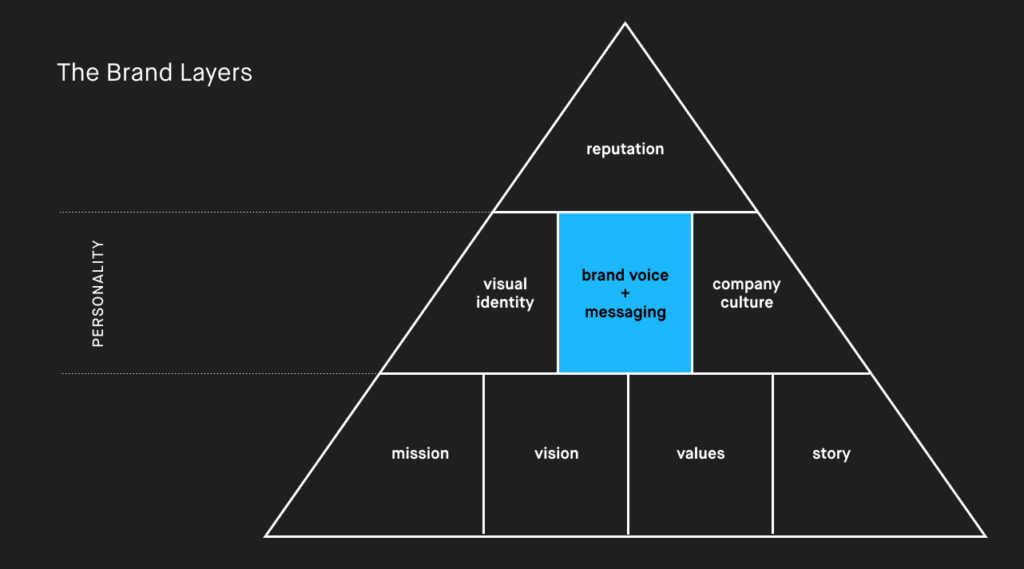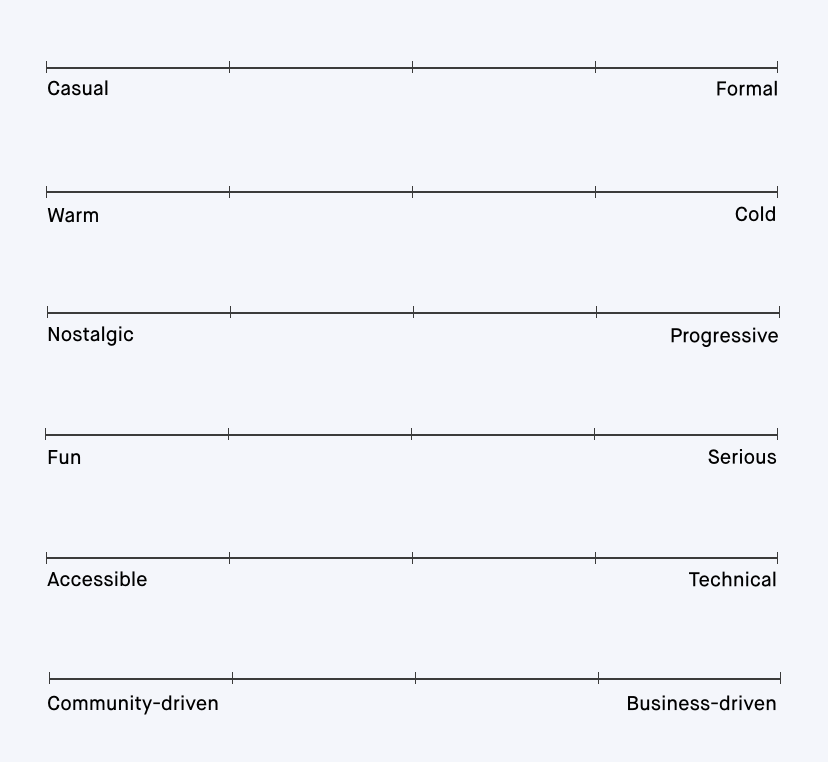Master your brand voice in 3 simple steps
Seeing as this is the beginning of the post, I suppose I should make an introduction.
“Hello” feels like a solid option; “Hi” makes things a little more friendly; “Greetings” elevates my message with extra polish; whereas “Sup” pushes things in an informal direction; and “Howdy” appeals to my Texas roots, but will it resonate here in North Carolina or around the world?
All are options (and to be clear, none are wrong). What the right words are for any of us merely depends on who we are, what feels authentic to each of us, and what we want the world to know about us.
The above illustrates how voice affects the way we communicate. Each phrase is a salutation — intended to introduce one party to another — but each is unique in its own way. And each tells you something about the person who’s saying it.
Think of voice like your personality brought to life through the words you choose and the messages you share. In short, voice is not only what you say, but also how you say it.
Why your brand’s voice matters
Voice is an essential element of brand identity. Just as with people, a brand’s voice is an outward expression of what you’re all about, what you care about, the way you see the world. Voice is the consistent, purposeful expression of your brand through language, across all the media and moments you connect with your audience.
When we read, our brain translates written language into spoken language. It’s why writing that feels like it’s written doesn’t feel like it’s talking to us. And writing that best matches written speech is copy we find engaging and persuasive.
And persuasion is really what it’s all about, isn’t it? All of us — especially marketers — are writing to persuade. Matching our written words to a spoken voice makes for more persuasive communication.
Every landing page headline. Every tweet. Every call-to-action. Every billboard, bio, and banner ad. These and dozens of other touch points are opportunities to express your brand’s personality — and therefore your story — to persuade your target customers.
Voice is essential to building a cohesive brand
At New Kind, we look at building brands through the lens of our Brand Layers framework — our way of looking at all the elements that go into what we call “branding.”
(By the way, if you’d like to learn more about the Brand Layers, register for our free webinar on Wednesday August 8th, 2018 from 11:30am – 12:30pm EDT)
The base layer of the Brand Layers is what we call the Purpose Layer, where you’ll find the foundational elements of your brand: the mission the drives you, the values you hold dear, the core story that expresses why your organization exists.
One level up sits the Personality Layer, which is where your foundational purpose comes to life: through the ways your brand looks, acts, and sounds.
- How you look is your visual identity: logo, colors, imagery, etc.
- How you act is your culture: your people, how you operate, who you hire, etc.
- How you sound is your messaging, story, and — most relevant for us today — your voice
The better you’re able to align your voice to the story your brand is telling, the more compelling and cohesive your brand identity will be.
3 ways to find your voice and keep it strong
Define your present, chart your future
As with any essential element of your brand, your voice should strike a balance between today’s realities and tomorrow’s aspirations. It has to feel authentic to who you are now, but also create a path to who you want to be in the future.
One way to do this is to ask yourself (and your working team): When you think about your brand’s voice — as it exists today, and what you imagine it might be in the future — what elements do we want to avoid, eliminate, preserve, or achieve?
- Avoid: What are we not doing now and never want to do?
- Maybe you’ve seen your competitors or other brands take their voice in a certain direction and thought, let’s make sure we never do that.
- Eliminate: What are we doing now but don’t want to keep doing in the future?
- Maybe you’ve noticed patterns in your written communication that don’t feel authentic to your understanding of your brand. Perhaps your brand will benefit from nixing these patterns from its vocabulary.
- Preserve: What are we doing now and want to keep doing in the future?
- Maybe certain content pieces you’ve created over the years stand out as examples of your authentic voice. Or maybe your customers have told you that the way you communicate resonates with them.
- Achieve: What are we not doing now but want to in the future?
- Maybe an award-winning piece of marketing blew you away at a recent conference, filling you with creative envy.
Use the findings from this activity to define your voice characteristics: 3-5 adjectives that describe your voice the way you might describe someone you know. Take care to brainstorm lots of options, deeply exploring the depths of your thesaurus. Playful, silly, whimsical, casual — all words that generally convey a similar tone. But which feels right for your brand?
If you get stuck, look outside for inspiration. Find brands you admire and ask yourself how you might describe their tone of voice. Mailchimp, Zappos, IBM, Slack, and many others have invested lots of time and resources in finding and articulating their most authentic brand voice — one that will resonate with their target customers. Imitation is a good way to get started.
Discuss the pros and cons of the options you come up with. Collect ideas from those who will be communicating on behalf of your brand every day. Just like your corporate values or mission statement, you want your voice characteristics to be internalized and understood broadly within your organization.
Here’s an easy activity to help you zero in on your characteristics.
Take the worksheet below, which outlines six common voice characteristics and their diametric opposites. Print the worksheet or replicate it on a whiteboard and have your team put sticky dots along each spectrum where they think your brand’s voice sits. Doing this together will help your working team begin to recognize patterns and find consensus. Once you have an idea of what general neighborhood your voice is in, you can pull out the thesaurus again to find the perfect words for you.
Use some star power
Some of the world’s leading brands work with spokespeople who embody the brand’s authentic personality. It’s a familiar strategy as old as marketing itself. The endorsement of a recognizable, relatable celebrity can lend near-instant credibility and authenticity to your brand.
That’s all well and good, you’re likely thinking, but a celebrity spokesperson is just a bit outside my budget.
Don’t fret. Even if you don’t quite have the same marketing budget as a Priceline (William Shatner) or Activia (Jamie Lee Curtis) you can still benefit from bringing a little star power to your communications strategy. I’ll explain.
As part of many branding projects here at New Kind, we ask clients to imagine a well-known personality who embodies their brand voice. In a workshop setting, we’ll have teams come together to identify the celebrity they think would fit their brand — someone they’d feel good about having represent who they are, someone whose own personality aligns with the brand’s.
A few names that often come up in brainstorming:
- Morgan Freeman: few voices are more iconic or recognizable than his — deep, resonant, and authoritative-yet-approachable.
- Patrick Stewart: the actor of stage and screen exudes a polished, intelligent, and artistic sensibility (the English accent doesn’t hurt either).
- Meryl Streep: refined, but still relatable, at once brilliant and still humble, conveying poise, grace, and skill. A living legend.
Your chosen spokesperson should aim to strike a balance between the voice you’re using today, while also being aspirational enough to help shape it into what you’d like it to become.
Bear in mind, your “celebrity” needn’t be a Hollywood A-Lister. If your company exists within a relatively niche industry, your writers and content creators — for whom the celebrity spokesperson is meant to be a useful tool — likely won’t resonate with a megawatt star like the ones listed above.
It’s important to remember the celebrity spokesperson is intended to be an internal tool that gives creators a filter to run their content through, allowing writers to ask themselves, “does this sound like something ________ would say?” before publication. If possible, try to find recorded interviews with your spokesperson to better understand how they actually sound when they talk.
At the end of the day, what matters most is that your spokesperson embody the authentic qualities you want your brand to communicate. Maybe your spokesperson is a YouTube talk show host, a renowned local chef, or even a fictional character — the choice is yours.
Make rules and follow them
Often we’ll see clients who undertake a brand voice project — conducting in-depth research, defining and refining their characteristics, finding alignment across the organization — only to see their team struggle when it comes time to start putting the voice into practice.
That’s why an essential final step in any voice project is to collect and catalog the discoveries and decisions you’ve made into a set of voice guidelines that can be shared with your team of content creators.
Defining your voice characteristics is only half the battle. You also need to help creators understand how they come across in written materials—translating the characteristics you’ve chosen into concrete rules, tips, and suggestions.
Without direction, few will know right off the bat how to write with a warm, confident, and trustworthy tone of voice. And even if they do, what one writer considers warm, confident, and trustworthy likely won’t align perfectly with what another writer thinks. The goal is to reach the point where everyone within your organization speaks as a chorus of voices, so the spirit and personality traits of your brand shine through no matter who authors your content.
Remember, the goal of formalizing your voice guidelines is not to limit your writer’s creative license, or to add additional steps to the creative process, but rather to ensure your organization is communicating consistently. The more consistent your voice, the more clearly your audience will hear you, and the more persuasive your story will be.
Document your voice guidelines and distribute them to your team — via an easily accessible online resource, a PDF, or through your company intranet. Whichever format you choose, just make sure it’s readily available and easy to find.
Closing thoughts
Voice is an oft-overlooked, but no less essential element of your brand identity. No doubt your organization has a powerful story to tell. Consistently sharing that story with an authentic voice will help ensure your target audience will hear it the way you intend.
We hope the thoughts and exercises we’ve shared will help you get started on your path to defining and owning your brand voice. Interested in learning more about New Kind and how we help organizations solve these and many other branding challenges? Don’t hesitate to get in touch. We’d love to hear your voice.


